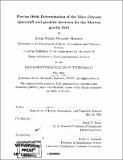| dc.contributor.advisor | Maria T. Zuber. | en_US |
| dc.contributor.author | Mazarico, Erwan Matías Alexandre, 1981- | en_US |
| dc.contributor.other | Massachusetts Institute of Technology. Dept. of Earth, Atmospheric, and Planetary Sciences. | en_US |
| dc.date.accessioned | 2005-09-27T17:18:35Z | |
| dc.date.available | 2005-09-27T17:18:35Z | |
| dc.date.copyright | 2004 | en_US |
| dc.date.issued | 2004 | en_US |
| dc.identifier.uri | http://hdl.handle.net/1721.1/28611 | |
| dc.description | Thesis (S.M.)--Massachusetts Institute of Technology, Dept. of Earth, Atmospheric, and Planetary Sciences, 2004. | en_US |
| dc.description | Includes bibliographical references (leaves 73-75). | en_US |
| dc.description.abstract | Remote sensing techniques are widely used in planetary science for acquiring precise, global inforniation about an object. One of these techniques consists of the study of the radio signals emitted by a spacecraft, from which it is possible to derive the forces acted upon it. For this project, we used the radio science data from the Mars-orbiting spacecraft "IMars Odyssey". Launched in April 2001, more than two years of daily radio tracking of this satellite are now available, allowing for Precision Orbit Determination. Using the program Geodyn, the position of the spacecraft with respect to the centre of mass of Mars is typically determined down to a few meters, while the velocity precision is better than 1 mm/s. Once a large number of orbits have been calculated, it is possible to use the residuals (misfits of the data to the modeled trajectory) to solve for some of the model parameters. Here, we determine the coefficients of the spherical harmonic expansion of the gravity field, as well as the drag coefficient of the satellite (a proxy for atmospheric density). To obtain such results, many high-precision data sets and models are combined: electromagnetic wave propagation, with tropospheric and ionospheric corrections; tracking station positions, including tidal and tracking station corrections; solar and thermal radiation; ephemerides of all the major bodies in the Solar System, plus the Martian moons. The inputs of the orbit determination program are the radio signals (Doppler and range), the angular momentum desaturations t.inings, the attitude (of the main bus of course, but also of the high-gain antenna and the solar panels), and a model of the spacecraft. Some results of this radio science experiment are pre-sented here, in the form | en_US |
| dc.description.abstract | (cont.) of gravity field spherical harmonic expansions sensed by the spacecraft. | en_US |
| dc.description.statementofresponsibility | by Erwan Matías Alexandre Mazarico. | en_US |
| dc.format.extent | 75 leaves | en_US |
| dc.format.extent | 3866623 bytes | |
| dc.format.extent | 3874314 bytes | |
| dc.format.mimetype | application/pdf | |
| dc.format.mimetype | application/pdf | |
| dc.language.iso | en_US | |
| dc.publisher | Massachusetts Institute of Technology | en_US |
| dc.rights | M.I.T. theses are protected by copyright. They may be viewed from this source for any purpose, but reproduction or distribution in any format is prohibited without written permission. See provided URL for inquiries about permission. | en_US |
| dc.rights.uri | http://dspace.mit.edu/handle/1721.1/7582 | |
| dc.subject | Earth, Atmospheric, and Planetary Sciences. | en_US |
| dc.title | Precise orbit determination of the Mars Odyssey spacecraft and geodetic inversion for the Martian gravity field | en_US |
| dc.type | Thesis | en_US |
| dc.description.degree | S.M. | en_US |
| dc.contributor.department | Massachusetts Institute of Technology. Department of Earth, Atmospheric, and Planetary Sciences | |
| dc.identifier.oclc | 57559815 | en_US |
